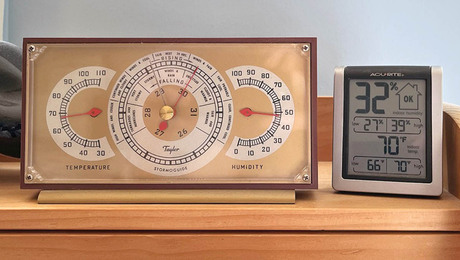My inlaws crawlspace has a fine powdery black mold Pretty much every where.(top, bottom, sides)This is a vented crawl 2-4 ft. high. There is no apparent moisture problems that are visible. I have checked very well for leaks, both water or air, but cant find anything. I assume someone has seen this before any guesses? Is there a specialty service for this or who do I call?
Discussion Forum
Discussion Forum
Up Next
Video Shorts
Featured Story

Source control, ventilation, and filtration are the keys to healthy indoor air quality. Dehumidification is important too.
Featured Video
Builder’s Advocate: An Interview With ViewrailHighlights
"I have learned so much thanks to the searchable articles on the FHB website. I can confidently say that I expect to be a life-long subscriber." - M.K.

















Replies
"I have checked very well for leaks, both water or air,"
How can there not be air leaks when it is vented.
Where is this located?
Bill, Thanks for the reply. This is in Raleigh NC. "air leaks" I was meaning ductwork.I am no stranger to home repair, I am a carpenter by trade. I have seen similar situation in a wet crawl, but never in the apparent "dry" condition.
You are in a perfect area for crawlspace problems.The area has warm moist air and it comes in the vented crawspace where the ground is relatively cool and the floor is cool from the AC you have condensation.Not to mention moisture coming from the ground unless it is sealed with poly.What is needed is a condtitioned crawlspace. FHB did a artical on it and JLC has done 2 in the last couple of years.IIRC both authors are in the genernal NC/SC area.
Bill, I think I remember the article in FHB. I agree that this is a ideal climate to need a conditioned crawl. Oddly enough, I dont think I have ever seen one down here.
Went to a seminar in Greensboro a couple of years ago and learned that mold needs water, a food source and air to live. Regarding water, all that is needed is a relative humidity of greater than 60%. Which, having lived in Raleigh for more than 20 years, I can testify is not hard to achieve. Are the ducts uninsulated and did you inspect at a time of year when you see condensation on the ducts?
Regarding remediation, there are a bunch of folks who are in that business in eastern North Carolina. Don't live in Raleigh anymore, but you may try something as simple as the yellow pages. Unfortunately, my notes from the seminar are in storage and virtually inaccessible at the moment or I could look up a couple of contractors for you. A couple of other sources would be a google search (which I just did). The search also yielded references to NCSU and to some state government offices, either of which could put you on the track of some remediation contractors.
Hope this helps.
Thanks, The air ducts are inulated and I just saw this last week. Not quite warm enough for the condensation.
I agree that conditioning the crawl space is the best option. However, you may want to try just putting a dehumidifier down there first. The objective is to get the relative humidity in the space below 60% and keep it there. A vapor barrier is an absolute must, especially if the house is situated on the brick quality clay that covers most of Raleigh.
I finished last year a multi year project digging out part of my crawl to make a basement shop. During that time, I tracked the humidity and was astounded at the difference it made in the humidity depending on whether I kept the excavation covered with plastic or not. If I didn't have the area covered with plastic, even with the dehumidifier running continuously, I couldn't bring the humidity below about 65% regardless of outside air humidity and I got some mold forming. Between being diligent with the vapor barrier and the dehumidfier I was able to get the humidity below 60% and kept the mold from reoccuring.
Over the long haul, conditioning the space will be your best option. I found that running the dehumidifier continuously to not be inexpensive. And, you have to empty it frequently or make provision for it to drain to the exterior of the space. But, you can get started solving the problem right away with a quick trip to Lowes to purchase one, bring it home and plug it in.
Good luck.
I think you are right and Im going to try the dehumidifier and certainly lay down a vapor barrier. What would you suggest for the existing mold? Is removing the insulation necessary, or will the lower humidity stop the growth of what is existing?
I can't answer your question about cleanup reliably. In my case, I just had a small amount and wiped it off the joists, it hadn't got to the insulation. You described having the entire crawl space contaminated with mold. I would be very, very cautious about cleaning up that much. A previous poster recommends leaving it alone and that may be a good choice, but it may not. I certainly wouldn't try cleaning up that much myself. I might try getting the humidity down to deny it the conditions under which it can live.
However, when I did a google on "mold remediation" "Raleigh North Carolina ", I noticed that in addition to several remediation contractors being listed, that the Mckimmon Center at NCSU is sponsoring a seminar on April 21. Here is the link http://continuingeducation.ncsu.edu/newsarchives/March2005-Engineering.htm . It is article 12. If I wanted to clean it up, I would try to find out more information about who is conducting the seminar, perhaps go, or at least contact them for some competent professional guidance about how to proceed. As you know, mold can make you very sick, and should be approached with caution.
Edit - I realized I didn't anwer your question directly. Based on what I learned in the seminar I attended a couple of years ago, if you can get the humidty below 60% and keep it there, then, no the mold can't live.
Edited 4/8/2005 4:30 pm ET by wilkesland
A restoration/cleaning type of company could spray the mold with a solution to kill it. Your insurance company might cover this so check with them. I have hired companies that work for insurance adjusters and they deal with mold.
Any mold is a problem, but stachybotrys (sp?) is the bad boy. I ran across a bad mold problem with a shower remodel a couple of years ago. Didn't know what kind it was, so I called the state Health Dept. and they gave me phone #'s for labs in my area that would test a sample. The Health Dept. should be able to give you some help with remediation as well.
Getting a sample to the lab was suprisingly low-tech. They told me to take celophane tape and press it to the mold. It will pull away enough for a sample. Seal it in a zip-lock baggy and drop it off at the lab.
"You couldn't pay me to run into a burning house. I'm a VOLUNTEER!
ADM,
I would remove any insulation and then wash everything down with detergent.
Close the vents. Stick a dehumidifier down there to dry everything out real good.
Then seal the crawlspace up.
This means that a heavy poly covers the floor of the crawl and is run up the walls and any piers and sealed with mastic. Any seams in the poly should be sealed with mastic. Any vents to the outside should be sealed closed.
Insulate the perimeter of the crawl with 2" styrofoam. If you want you can cover that with 1/2" thermax(?) (styro with a foil covering) to slow down the development of smoke in a fire (or just get 2" thermax...I think they make it?). Code might require the thermax.
Be sure to insulate the rim joists as well. Not a bad idea to leave the sill plate exposed so termite trails will be visible.
Finally, find a unobtrusive spot to put a hole in the living area floor, run a duct a few feet from the hole and stick a fan (moving about 1 cfm of air for each 50 square feet of crawlspace) on the end of it.
Disclaimer: I am working almost entirely off of what I've learned from magazine articles and threads here at Breaktime and what I've observed in many crawlspaces. I'm bidding these jobs, but I haven't gotten any yet.
Rich Beckman
Another day, another tool.
Rich, Sealing the crawl seems drastic, although this might be the answer to the problem.Im not following the hole in the living room floor. Could you not run a duct of the main trunk, or is the hole and fan the inexpensive approach to conditioning the crawl?
"Could you not run a duct of the main trunk, or is the hole and fan the inexpensive approach to conditioning the crawl?"That's a good question....I'm guessing one reason for the hole in the floor with a fan approach is that the HVAC doesn't (normally) run 365 days a year.Rich BeckmanAnother day, another tool.
good point, lol
ADM,
Unless you have a very specific reason for seeking out and eliminating mold, I would recommend you do absolutely nothing, except stay out of the crawl space as much as possible. Incidental mold is only a problem if you mess with it.
Edited 4/8/2005 11:59 am ET by Timbo